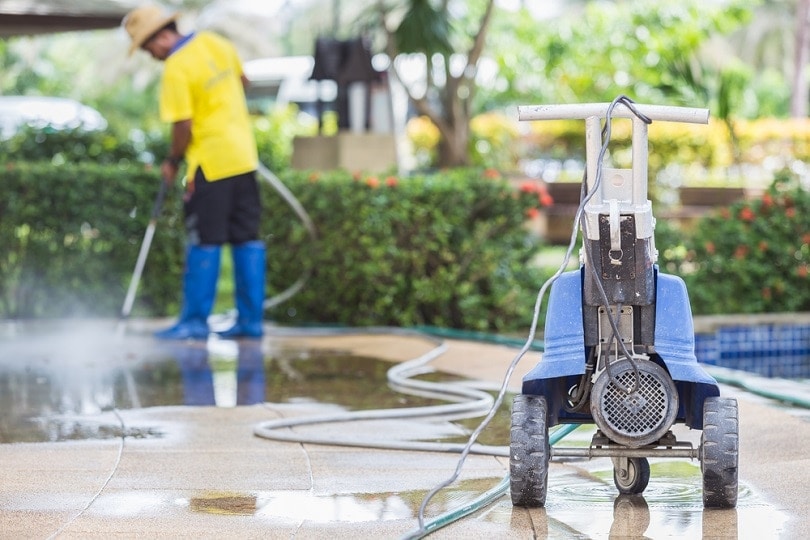Who Invented the Pressure Washer & When? (History)
-
Pete Ortiz
- Last updated:

Happy accidents lead to some of humanity’s most significant discoveries. Such was the case in 1926 when Frank W. Ofeldt II discovered the power of pressure washing by watching steam discharging from a whiskey still.
Ofeldt noticed that, when forced through a small tube, the high-pressure steam cleared patches of grease from the floor. With an eye for potential and a pioneering mindset, he soon laid the foundation for what would become a $1.8 billion industry and one of the most cathartic weekend projects a homeowner can enjoy today.
Pressure Washer Origins
Fortunately, Ofeldt made the chance observation at his home in Moon Township, Pennsylvania. He was a third-generation steam engineer, the grandson of Frank W. Ofeldt I, an innovator in steam boiler and gasoline-powered motor-boat designs in the 1880s. The vapor generator was a clever solution to steam engine regulations at the time and, in many ways, set Ofeldt II up for his invention 40 years later.
The pedigree was there, and in 1926, the setting was perfect for Ofeldt to make his discovery.
With the passage of the Volstead Act in 1919, America entered Prohibition and began its 14-year hiatus from hard beverages. Of course, most of America wasn’t ready to give up the drink that easily.
Instead, most people retreated to speakeasies and took up bootlegging to sidestep the law. Ever the opportunist, Ofeldt, who at the time was working in the gas-fired water heater and boiler business, took the chance to construct whiskey stills for local moonshiners.
While building a still, Ofeldt saw that the high-pressure steam from one of the outlets was displacing the grime on his garage floor. Seeing how it made the grease move around, he began considering how he could optimize the wet steam technique as an effective cleaner.
In search of a pump casting to help form the hose for his concept, Ofeldt connected with the Homestead Valve Company. He partnered with the company’s manager, Frederick E. Schuchmann, to develop the “Hypressure Vapor Spray Generator.” Disliking the name, they eventually heard the suggestion to change it to “Hypressure Jenny.” Ofeldt soon became the Chief Engineer of the Hypressure Jenny division, and the brand continues operating today.

Alfred Karcher
After the Hypressure Jenny came into being, steam cleaning technology rose in popularity. In 1950, pressure washer development took a critical turn when German inventor Alfred Kärcher created the first hot water high-pressure cleaner, the DS350. The water-heating design would become the basis for modern pressure washers.
Karcher passed away 9 years after creating his first pressure washer, but his company continued to flourish around the concept. His wife (and the business brains behind the operation), Irene Kärcher, would go on to introduce the HD555 in 1984, the first portable pressure washer for personal use at home.
1960s–1980s: Pressure Washing Pump Innovations
Pump technology upgrades were the primary driver of pressure washer evolution, with critical innovations arriving in the late 1960s and 1970s. To that point, reciprocating pistons in electric-powered units used rubber seals. Their potential RPMs were limited, and the parts didn’t last long before needing maintenance. Most options weren’t sufficient for the industries that needed pressure washing technology.
Cat Pumps changed the game when William L. Bruggeman started it in 1968. Bruggeman created the “Uniflow” piston pump, the flagship product of his new company. The initial prototype had a 4 GPM flow rate and could run at 700 psi. The pump earned a reputation for reliability, lasting up to ten times longer than conventional pumps.
In 1975, Cat Pumps unveiled the sleeved piston pump for gas-engine pressure washers, capable of reaching 3,000 psi. The ceramic plunger pump came a few years later, in 1978. The design included a new double seal that extended pressure washer longevity and increased pressure.
With the new technology, pumps could last for over 2000 operating hours with minimal maintenance. Cat Pumps could now meet the demand of several industries, particularly the car wash sector, the company’s primary business at the time. With direct coupling to gas and electric motors, their speeds doubled from a maximum of around 1,800 RPMs to a new standard of 3,600 RPMs.

Conclusion
We’ve come a long way since the days of Ofeldt’s Steam Jenny. Today’s gas-powered consumer pressure washers can discharge water at up to 3,000 psi, and commercial units can pressurize it to well over 20,000 psi! We owe much of our modern technology to the pioneers in ceramic plunger pumps in the 1980s. But none of it would have been possible without one tiny yet incredibly fortunate chance occurrence in 1926.
Featured Image Credit: bubutu, Shutterstock
Contents



